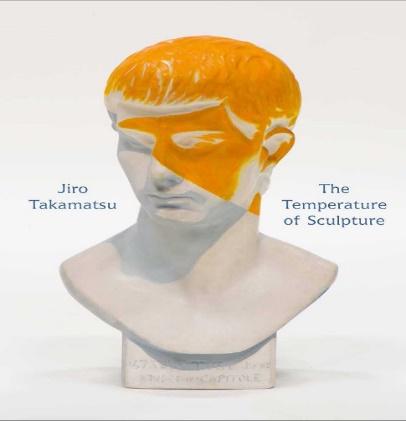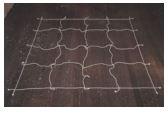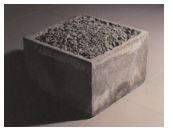Jiro Takamatsu was a Japanese artist who worked in a variety of mediums, including painting, sculpture, and installation art. He is best known for his enigmatic and often dark paintings, which often explore the nature of perception and illusion. Takamatsu was born in 1936 and began his artistic career in the early 1960s1. Throughout his career, he remained highly experimental and pushed the boundaries of traditional mediums. In 1968, he famously painted an entire room black and refused to allow any light into it; viewers were able to experience the work by walking around with flashlights.
Jiro Takamatsu was one of the founding members of Mono-ha, and his pieces often featured natural materials like rocks, wood, and glass. He was known for his minimalist aesthetic and for using everyday objects in surprising ways. Takamatsu frequently explored the relationships between objects and their surroundings, seeking to create a sense of equilibrium or imbalance within his compositions. Many Mono-ha artists were strongly influenced by Zen philosophy, which emphasizes the importance of harmony with nature and the transcendence of materialism. In this sense, Takamatsu’s work can be seen as an embodiment of Mono-ha’s spiritual ideals.
Some of Takamatsu’s artworks were “The Temperature of the Sculpture”, “Cube 6 + 3, 1968”, “Oneness of Concrete, 1971”, “Slack of Cloth, 1969”, and “Slack of Net, 1968–69”.
The work is composed of a human head sculpture that could have been made from bronze, brass, aluminum, and other materials that were meant to express the “temperature” or “atmosphere” of their respective environments. The work could have been interpreted as being born out of its social circumstances – specifically, the artist’s response to the heated political climate in Japan during the 1960s2. Additionally, Takamatsu may have used materials (metals in particular) is seen as a commentary on the industrialization and modernization that was occurring at the time.

Takamatsu was born in Japan during a time when the country was going through a rapid modernization process. This change in society led to new ideas and concepts that artists could explore in their work. In “The Temperature of the Sculpture,” Takamatsu may have used the materials and tools available to him to express this change in Japanese society. For example, he used different shades to color the art, which created the sculpture’s dynamic shapes, which reflects how technology was changing people’s lives at that time. Overall, Takamatsu’s work shows how art can be reflective of its social context, technological development, and surroundings.
‘Slack of Net, 1968–69’ is a piece of art by Jiro Takamatsu that reflects on the tension between humans and the internet; the art was 215 x 215 cm. The artist created it at a time when the internet was in its infancy, and people were only starting to become aware of its potential. The work consists of an empty room with a large net in the center. The net could have been made from white metal cables with white cotton strings, and it is so large that it covers most of the floor.

Takamatsu’s “Slack of Net” series could be intimately connected to the political and social unrest of 1960s Japan. After World War II, Japan experienced a period of intense economic growth, which led to an increase in materialism and consumerism. The artist could be critical of this new societal paradigm and sought to create art that reflected the spiritual emptiness he saw in society. In the “Slack of Net” series, Takamatsu could have used netting as a metaphor for the way in which society traps people in its Material world. He may have created sculptures out of found objects that were suspended in netting, emphasizing how people are entangled in the web of society. Similarly, the idea behind it could be that the net represents both opportunity and danger, as it can be used to catch prey but also to ensnare people.
Jiro Takamatsu’s Oneness of Concrete, 1971, was born out of its social circumstances; it was estimated at 40 x 60 x 60 cm at the Shizuoka Prefectural Museum of Art. The work is a simple clay rectangular clay box with soil in it. The title, Oneness of Concrete, could reflect the artist’s attempt to reconcile the abstract and the concrete in his artwork. Takamatsu was born into a family of potters and spent his early years working in the family kiln. He later moved away from traditional ceramic forms and began making sculptures and paintings that were inspired by Zen Buddhism and by postwar Japanese society. In particular, he was interested in how people were adapting to their new urban environment.

In the early 1970s, Japan was experiencing a period of great economic growth. This newfound wealth led to a renewed interest in Western art, and artists began exploring new ways to incorporate Western styles into their work. Takamatsu’s “Oneness of Concrete” is a rectangular clay box with soil in it. The artist may have created the work in response to the growing commercialism and materialism of Japanese society. Similarly, he maybe wanted to create a work that would remind people of the importance of nature and the natural world.
Takamatsu’s Cube 6 + 3, 1968, is considered an important work of art from the Gutai movement, which was a Japanese avant-garde art movement in the 1950s and 1960s. The art measured 13 x 13 x 13 inches or 33 x 33 x 33 cm. The Mono-ha movement was born out of its social circumstances – Japan’s post-war period. After World War II, Japan was left in a state of chaos and destruction. This created an environment where artists were searching for new ways to express themselves and their ideas. Takamatsu’s Cube 6 + 3 is made from a blue square lacquered wood with a string. It is simple, but it embodies the spirit of the Mono-ha movement – to create art that is expressive and innovative.

“Slack of Cloth, 1969” is an artwork by Jiro Takamatsu that was born out of its social circumstances. The work is a cream square piece of cloth that measures approximately 360 x 360 cm at the Shizuoka Prefectural Museum of Art. It could have been created in 1969 as a protest against the Vietnam War3. The title of the work could refer to the idea that war leaves behind “slack” or excess fabric–in this case, referring to the amount of cloth used to make military uniforms. The work is made from a single scrap of cloth and is meant to be ephemeral, representing the idea that war is wasteful and short-lived. Takamatsu’s work highlights the human cost of war and its devastating effects on society. When the piece was created, Japan was going through a time of great political turmoil. The country had just suffered a major defeat in World War II, and the American occupation was underway. Takamatsu could have created this piece as a direct response to these events.

Bibliography
Dixon, Chris, and Jon Piccini. “The Anti-Vietnam War Movement: International activism and the search for world peace.” In The Routledge History of World Peace Since 1750, Routledge, 2018.
Kee, Joan. “Points, lines, encounters: The world according to Lee Ufan.” Oxford Art Journal, 2008.
Muramatsu, Michio, and Ellis S. Krauss. “The conservative policy line and the development of patterned pluralism.” In Critical Readings on the Liberal Democratic Party in Japan, Brill, 2018.
Footnotes
- Kee, Joan. “Points, lines, encounters: The world according to Lee Ufan.” Oxford Art Journal, 2008.
- Muramatsu, Michio, and Ellis S. Krauss. “The conservative policy line and the development of patterned pluralism.” In Critical Readings on the Liberal Democratic Party in Japan, Brill, 2018.
- Dixon, Chris, and Jon Piccini. “The Anti-Vietnam War Movement: International activism and the search for world peace.” In The Routledge History of World Peace Since 1750, Routledge, 2018.